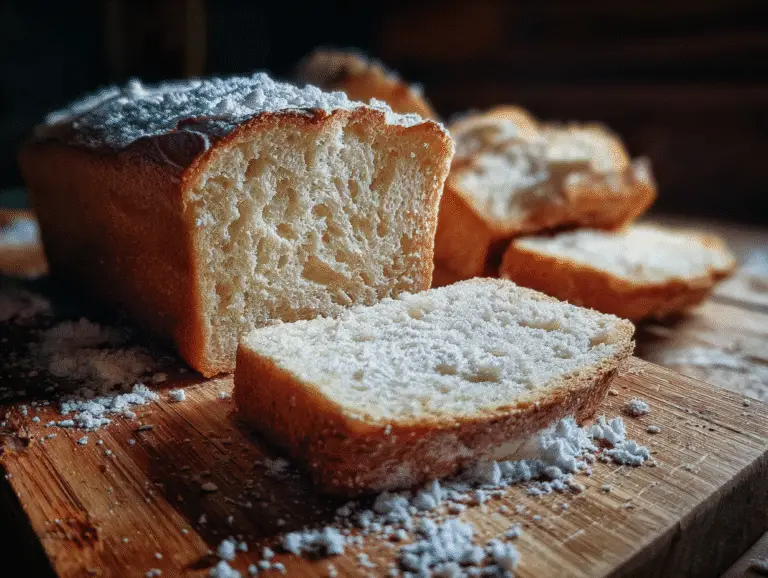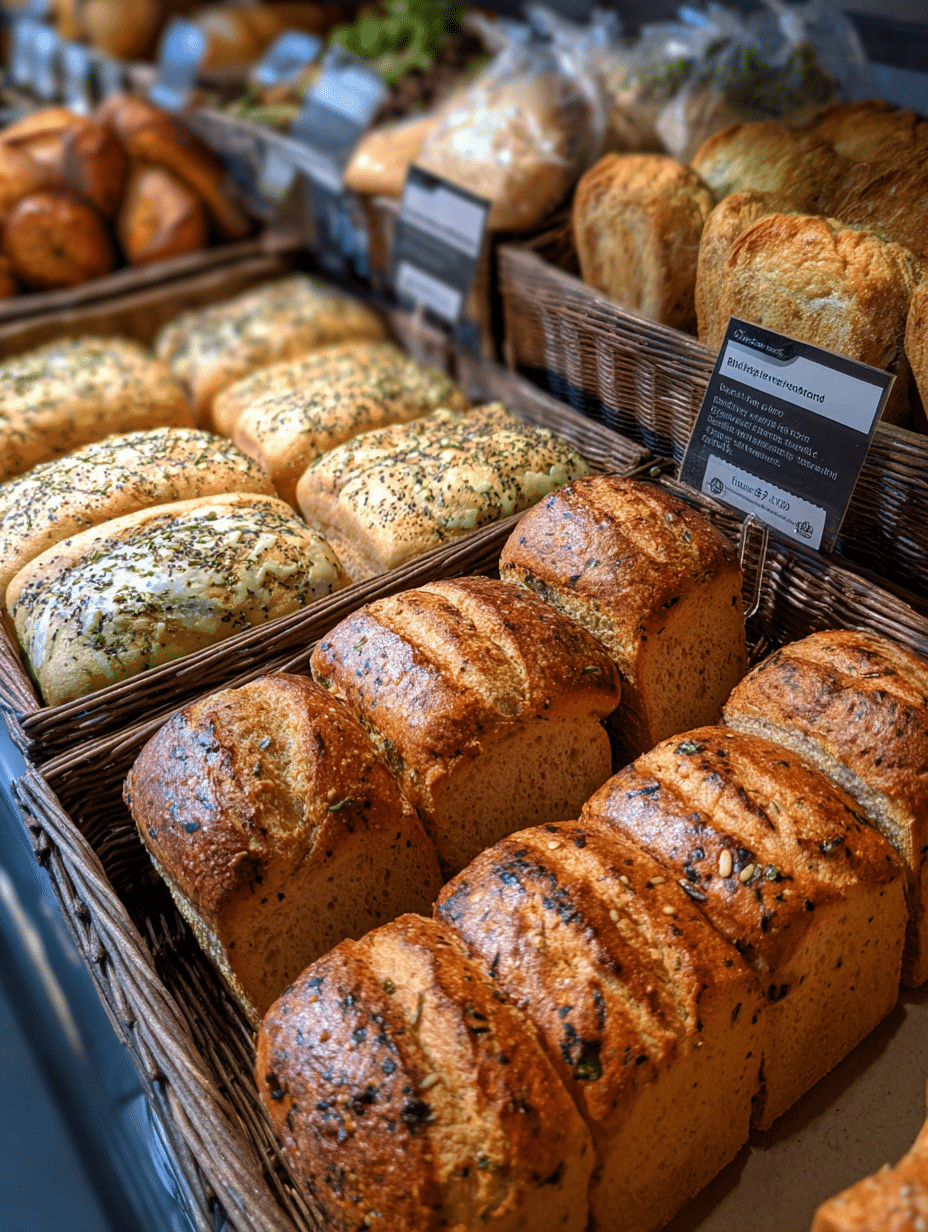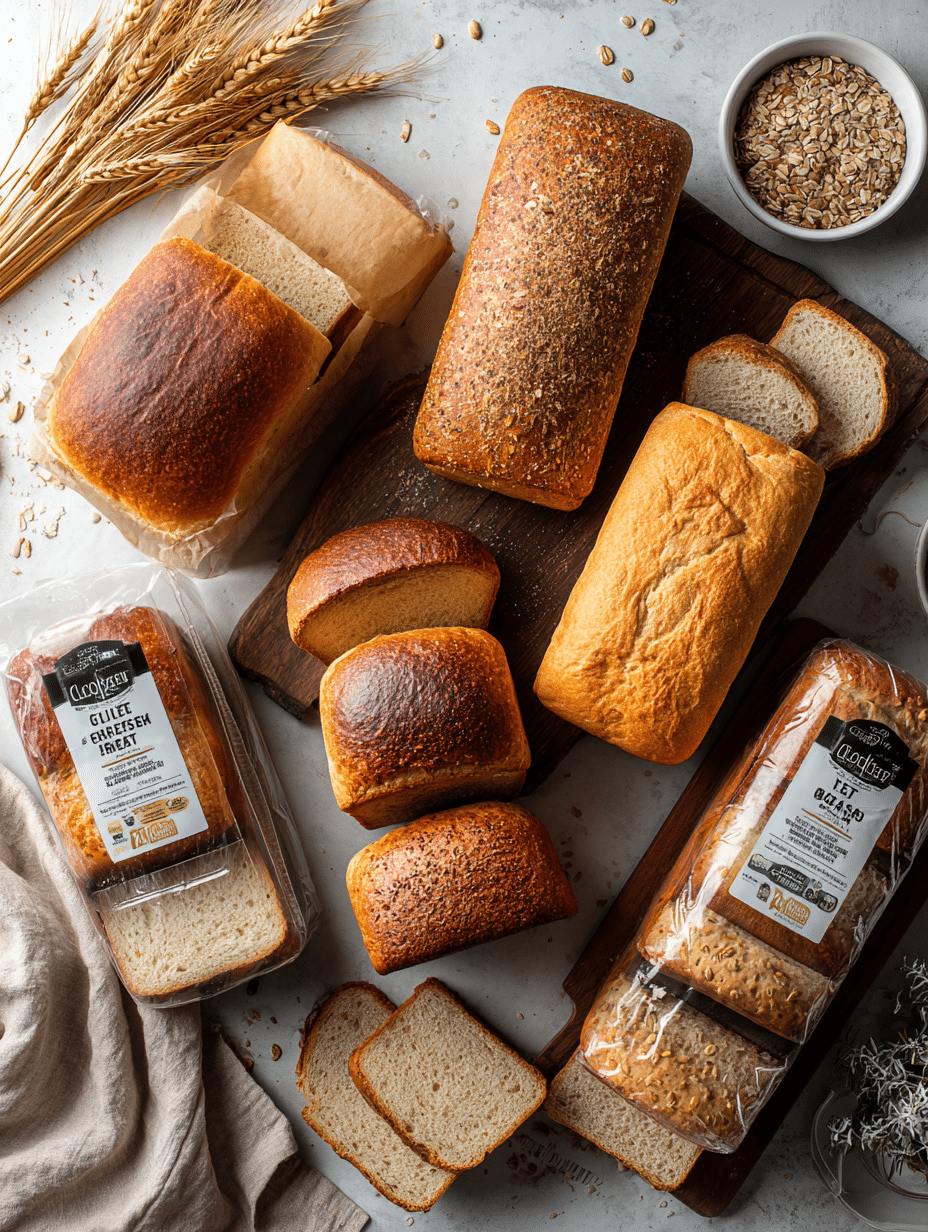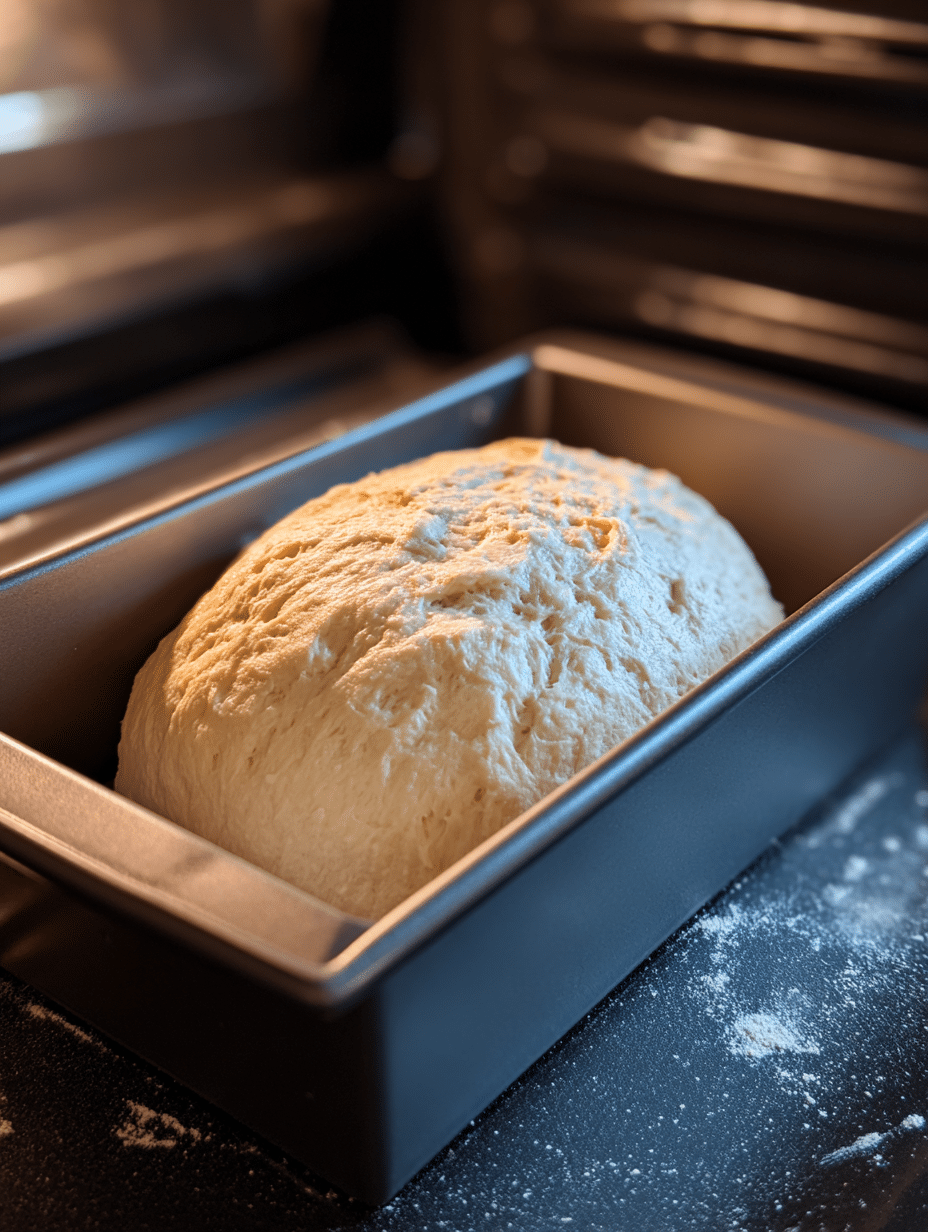If you’ve been searching for a way to enjoy bread without the side effects of gluten, gluten free bread is your answer. Whether you have celiac disease, a mild gluten sensitivity, or you’re just trying to eat cleaner, this bread alternative has come a long way from the dry, flavorless loaves of the past. Today’s gluten free bread is soft, rich in nutrients, and surprisingly satisfying.
This article dives deep into the world of gluten free bread—from understanding what it is and how it supports digestive health, to uncovering myths, reviewing store-bought options, and exploring how to bake the perfect loaf at home. You’ll also learn whether sourdough bread is truly gluten-free and which brands make the best gluten-free loaves in the market.
Don’t miss our keto cottage cheese egg bake, a delicious low-carb and gluten-free dish that pairs well with your favorite bread alternatives.
Table of Contents

Gluten Free Bread – The Best Guide to Baking, Buying & Enjoying Guilt-Free
Get ready to indulge in the perfect balance of sweet and soft! This gluten-free banana bread features just the right amount of sugar for a deliciously tender texture.
- Total Time: 1 hour 5 minutes
- Yield: 14 slices 1x
Ingredients
- 2 cups gluten‑free flour baking blend (220 g)
- 1½ tsp baking powder
- ½ tsp baking soda
- ½ tsp fine salt
- 6 tbsp melted butter (65 g)
- ½ cup coconut sugar (65 g) or brown sugar
- 2 large eggs
- 1½ tsp pure vanilla extract
- 4 very ripe bananas, mashed (about 1½ cups / 350 g)
- ¾ cup chocolate chips (plus more for top)
- Prep Time: 10 minutes
- Cook Time: 55 minutes
- Category: Bread
- Method: Baking
- Cuisine: American
- Diet: Gluten Free
Nutrition
- Serving Size: 1 slice
- Calories: 240
- Sugar: 14g
- Sodium: 125mg
- Fat: 11g
- Saturated Fat: 6g
- Carbohydrates: 37g
- Fiber: 2g
- Protein: 3g
What is Gluten Free Bread?
Understanding Gluten and Its Effects on the Body
Gluten is a protein found in wheat, barley, and rye—three grains commonly used in traditional bread-making. It gives bread its chewy structure. However, for individuals with celiac disease or gluten sensitivity, consuming gluten leads to inflammation, discomfort, and even long-term gut damage.
That’s where gluten free bread comes in. Made without these grains, it’s designed to mimic the taste and texture of traditional bread without triggering health issues. Going gluten-free isn’t just a trend—it’s a necessary lifestyle for millions.
What Makes Bread Gluten-Free?
To qualify as gluten-free, bread must be made without any wheat, rye, or barley derivatives. That means no all-purpose flour, whole wheat flour, or malt. Instead, gluten free bread is often crafted using:
- Rice flour
- Sorghum flour
- Almond flour
- Buckwheat flour
- Tapioca starch
- Potato starch
- Arrowroot
- Psyllium husk or xanthan gum to bind the dough
For safety, always look for loaves labeled “certified gluten-free,” as cross-contamination in facilities is a serious concern for those with celiac disease.
Ingredients Commonly Used in Gluten-Free Bread
Below is a breakdown of the most popular ingredients used to create delicious, safe gluten free bread:
| Ingredient | Role in Bread Texture | Gluten-Free Status |
|---|---|---|
| White/Brown Rice Flour | Base ingredient for soft texture | ✅ Yes |
| Tapioca Starch | Adds elasticity & chewiness | ✅ Yes |
| Almond Flour | Brings healthy fats & flavor | ✅ Yes |
| Sorghum Flour | Mild taste, good structure | ✅ Yes |
| Xanthan Gum | Mimics gluten binding | ✅ Yes |
| Psyllium Husk | Adds fiber and elasticity | ✅ Yes |
| Buckwheat Flour | Nutty flavor, hearty texture | ✅ Yes |
Many brands also experiment with blends to get that “just like wheat” feel. If you’re baking at home, testing different combinations is key to finding your perfect loaf.
Check out this chocolate chip banana bread recipe—an indulgent twist that can be made gluten-free with simple swaps.
Types of Gluten Free Bread You Should Try

The Best Store-Bought Gluten Free Bread Options
Not all gluten free bread is created equal—some brands hit the mark with soft texture and great flavor, while others fall flat. To help you make the right choice, here are some of the top-rated store-bought gluten free bread options available in the U.S.:
| Brand | Best Feature | Certified Gluten-Free | Price (avg/loaf) |
|---|---|---|---|
| Canyon Bakehouse | Soft texture, no aftertaste | ✅ Yes | $6.49 |
| Udi’s | Classic taste, wide variety | ✅ Yes | $5.99 |
| Schär | Shelf-stable, great for toast | ✅ Yes | $6.79 |
| Little Northern Bakehouse | Vegan & GF blend | ✅ Yes | $6.99 |
| Aldi LiveGFree | Affordable & tasty | ✅ Yes | $4.39 |
These loaves are perfect for sandwiches, toast, or even French toast. Just be sure to check the label—some may include dairy or eggs, which may not suit all diets.
Discover great ideas like cottage cheese bagels, a creative gluten-free breakfast option that’s both high in protein and satisfying.
Homemade Gluten Free Bread Recipes (Including Flour Varieties)
If you prefer to control your ingredients, baking your own gluten free bread at home is the way to go. The best part? You can customize texture, taste, and nutrition. Here are some popular gluten-free flour combinations to try:
- Rice Flour + Tapioca + Potato Starch – light and fluffy texture
- Oat Flour + Sorghum + Psyllium Husk – great for fiber and structure
- Almond Flour + Coconut Flour – lower carb, rich in healthy fats
When baking at home, using binders like xanthan gum or psyllium husk is essential to mimic the elasticity gluten provides.
For a sweet, comforting twist, check out this chocolate chip banana bread. With a few substitutions, it becomes a moist and gluten-free treat perfect for any time of day.
Comparing Gluten Free Sandwich Bread vs Artisan Loaves
Gluten free sandwich bread is typically made for convenience—thin slices, light texture, and a mild flavor that pairs well with any filling. Artisan gluten free loaves, however, aim for heartiness and crusty exteriors, often using aged doughs or fermentation methods.
Here’s a quick comparison:
| Bread Type | Texture | Flavor Profile | Best Use |
|---|---|---|---|
| Sandwich Loaf | Soft, fluffy | Neutral | Toasts, sandwiches |
| Artisan Loaf | Dense, crusty | Bold & nutty | Dips, soups, platters |
For those who enjoy richer baked goods, don’t miss our sticky banana bread cinnamon rolls. With gluten-free flour swaps, it becomes a brunch favorite.
Health Benefits of Gluten Free Bread
How Gluten Free Bread Supports Digestive Health
One of the biggest advantages of eating gluten free bread is improved digestive comfort—especially for individuals with celiac disease or gluten sensitivity. Gluten can irritate the lining of the small intestine in these people, leading to bloating, cramps, gas, or even long-term inflammation.
Switching to gluten free alternatives can reduce these symptoms significantly. Many breads made without gluten are also rich in gut-friendly ingredients like psyllium husk, chia seeds, or prebiotic flours like sorghum and buckwheat.
Notably, gluten free bread that contains added fiber or seeds may even help regulate digestion, which is a bonus for those who struggle with IBS or irregularity.
Don’t miss our banana bread with cinnamon crunch, which can easily be made gluten-free and includes ingredients that support gut health.
Gluten-Free Diet Benefits for People with Celiac or Gluten Sensitivity
Celiac disease is an autoimmune condition triggered by gluten. Even a small crumb of wheat bread can damage the intestines of someone with this condition. For these individuals, gluten free bread is not a trend—it’s essential to their health.
Here’s what going gluten-free can improve for them:
- Nutrient absorption
- Intestinal healing
- Energy levels
- Reduced headaches or migraines
- Balanced immune response
Even those without celiac may feel better on a gluten-free diet if they experience sensitivity. Symptoms like skin rashes, joint pain, or foggy thinking often improve when gluten is removed.
But remember: gluten free bread isn’t inherently healthier for everyone. Some gluten-free products are ultra-processed and contain more sugar or fat to enhance flavor. Always read the label carefully.
Is Gluten Free Bread Healthier Than Regular Bread?
That depends. If you’re comparing a clean, whole-grain gluten free bread made with oats, seeds, and no additives to a white flour sandwich loaf full of preservatives, yes—it’s healthier. However, if you’re eating highly processed gluten-free bread with little fiber or protein, it may not be much better nutritionally.
Here’s a side-by-side:
| Feature | Regular Wheat Bread | Gluten Free Bread |
|---|---|---|
| Contains Gluten | ✅ Yes | ❌ No |
| Fiber (avg per slice) | 1g – 2g | 2g – 4g (if multigrain) |
| Protein | 3g – 5g | 2g – 4g |
| Sugar Content | 2g – 4g | Can range 0g – 6g |
| Additives/Preservatives | Common | Depends on brand |
As with all food choices, quality matters. Look for certified gluten free bread with whole ingredients like quinoa flour, flaxseeds, or millet for the most benefits.
Learn more about pink salt’s impact on weight loss—a powerful natural aid often paired with clean eating lifestyles like gluten-free diets.
The Truth About Doctors Opposing Gluten-Free Diets
Why Are Many Doctors Skeptical About Gluten-Free Diets?
Despite the rising popularity of gluten free bread and products, many healthcare professionals caution against the diet for the general public. But why?
Here’s the truth: if you don’t have celiac disease or gluten sensitivity, removing gluten might not improve your health—and in some cases, it can even be counterproductive. Doctors worry that many people jump into a gluten-free lifestyle without understanding the nutritional trade-offs.
Going gluten-free often means cutting out key fiber-rich whole grains like barley and whole wheat. This can lead to:
- Lower fiber intake
- Fewer B vitamins and minerals
- Increased reliance on processed foods
Some gluten free bread options compensate with refined starches and added sugar, which can spike blood sugar and increase cravings—ironically making the “healthier” choice less healthy.
When Going Gluten-Free is Not Recommended
Doctors generally don’t recommend a gluten-free diet unless it’s medically necessary. Here’s when skipping gluten might do more harm than good:
- No diagnosis: If you haven’t tested positive for celiac or gluten intolerance, removing gluten can mask symptoms and complicate diagnosis.
- Poor planning: Replacing wheat with gluten-free cookies, crackers, and bread lacking nutrients doesn’t improve diet quality.
- Children and teens: Eliminating gluten without supervision can impact growth and development.
The solution? Work with a dietitian before starting any restrictive diet—even a gluten-free one.
Still, many enjoy gluten free bread for its variety of grains, better digestion, or lower allergen content. If it works for you, great! Just don’t assume it’s automatically better for everyone.
Medical Myths vs Facts About Gluten and Modern Diets
Let’s separate fact from fiction:
| Claim | Fact or Myth? | Explanation |
|---|---|---|
| “Gluten is toxic for everyone” | ❌ Myth | Only harmful for those with diagnosed intolerance |
| “Gluten-free equals healthier” | ❌ Myth | Depends on ingredients, not the absence of gluten |
| “Gluten causes weight gain” | ❌ Myth | Overeating and poor food choices are the cause |
| “Celiac disease is just a trend” | ❌ Myth | It’s a serious autoimmune disorder |
| “Gluten free bread is safe for celiacs” | ✅ Fact | If certified gluten-free, it’s safe to consume |
Looking for inspiration? Try cottage cheese banana bread as a nutrient-rich, gluten-free option that doesn’t sacrifice flavor.
Is Sourdough Bread Gluten Free?
Fermentation and Its Impact on Gluten
Sourdough bread is made through a natural fermentation process involving wild yeast and lactic acid bacteria. This fermentation partially breaks down gluten and other complex proteins, making the bread easier to digest. Because of this, many people wonder if sourdough qualifies as gluten free bread.
But here’s the reality: while fermentation reduces the gluten content in sourdough, it does not eliminate it entirely unless made with gluten-free flours from the start. Traditional sourdough made with wheat still contains enough gluten to be unsafe for anyone with celiac disease or true gluten sensitivity.
For the general public, this breakdown might make sourdough feel “lighter” or easier on the stomach, but it’s not medically safe for those who must avoid gluten completely.
Can Sourdough Be Safe for Gluten-Sensitive People?
Some individuals with mild gluten intolerance (not celiac disease) report fewer symptoms when eating long-fermented sourdough bread. However, this isn’t a guarantee—and should not be taken as medical advice.
To enjoy the taste and health benefits of sourdough without risking gluten exposure, look for or make:
- Certified gluten free sourdough bread made from gluten-free flours
- Recipes using a gluten-free sourdough starter
- Blends with buckwheat, sorghum, brown rice, or millet
There are now several artisan bakeries and online shops offering safe sourdough versions that qualify as real gluten free bread.
Check out easy homemade pakora mix as another naturally gluten-free option using gram flour—a great complement to sourdough-style dishes.
Differences Between Traditional and Gluten Free Sourdough
Let’s break it down:
| Feature | Traditional Sourdough | Gluten Free Sourdough |
|---|---|---|
| Base Flour | Wheat, Rye, Spelt | Sorghum, Rice, Buckwheat |
| Fermentation | Long, 12–48 hours | Same or longer |
| Gluten Content | Reduced but present | 0% (certified gluten free) |
| Safety for Celiacs | ❌ Not safe | ✅ Safe if certified |
| Availability | Common in bakeries | Limited but growing |
If you’re craving that signature tangy flavor and chewy crust, gluten free sourdough might just be your new favorite gluten free bread.
Is Sourdough Bread Gluten Free?

Fermentation and Its Impact on Gluten
Sourdough bread is made through a natural fermentation process involving wild yeast and lactic acid bacteria. This fermentation partially breaks down gluten and other complex proteins, making the bread easier to digest. Because of this, many people wonder if sourdough qualifies as gluten free bread.
But here’s the reality: while fermentation reduces the gluten content in sourdough, it does not eliminate it entirely unless made with gluten-free flours from the start. Traditional sourdough made with wheat still contains enough gluten to be unsafe for anyone with celiac disease or true gluten sensitivity.
For the general public, this breakdown might make sourdough feel “lighter” or easier on the stomach, but it’s not medically safe for those who must avoid gluten completely.
Can Sourdough Be Safe for Gluten-Sensitive People?
Some individuals with mild gluten intolerance (not celiac disease) report fewer symptoms when eating long-fermented sourdough bread. However, this isn’t a guarantee—and should not be taken as medical advice.
To enjoy the taste and health benefits of sourdough without risking gluten exposure, look for or make:
- Certified gluten free sourdough bread made from gluten-free flours
- Recipes using a gluten-free sourdough starter
- Blends with buckwheat, sorghum, brown rice, or millet
There are now several artisan bakeries and online shops offering safe sourdough versions that qualify as real gluten free bread.
Check out easy homemade pakora mix as another naturally gluten-free option using gram flour—a great complement to sourdough-style dishes.
Differences Between Traditional and Gluten Free Sourdough
Let’s break it down:
| Feature | Traditional Sourdough | Gluten Free Sourdough |
|---|---|---|
| Base Flour | Wheat, Rye, Spelt | Sorghum, Rice, Buckwheat |
| Fermentation | Long, 12–48 hours | Same or longer |
| Gluten Content | Reduced but present | 0% (certified gluten free) |
| Safety for Celiacs | ❌ Not safe | ✅ Safe if certified |
| Availability | Common in bakeries | Limited but growing |
If you’re craving that signature tangy flavor and chewy crust, gluten free sourdough might just be your new favorite gluten free bread.
Choosing the Best Gluten-Free Loaf

Best Gluten Free Bread Brands Ranked by Taste and Texture
When you’re standing in the bread aisle overwhelmed by options, knowing which gluten free bread delivers on flavor, texture, and nutrition makes all the difference. The following brands consistently receive high ratings from gluten-free communities and dietitians alike:
| Brand | Texture Score | Flavor Score | Best Feature |
|---|---|---|---|
| Canyon Bakehouse | 9/10 | 8.5/10 | Soft, no toasting needed |
| Little Northern Bakehouse | 8.5/10 | 8.7/10 | Vegan-friendly & seed-rich |
| Schär Artisan Baker | 8/10 | 9/10 | Classic European taste |
| Udi’s Gluten Free | 7.5/10 | 8/10 | Widely available, balanced sweetness |
| Three Bakers Whole Grain | 8/10 | 8.2/10 | Hearty & high in fiber |
Every brand has its strengths, but if you’re new to gluten free living, Canyon Bakehouse and Schär are excellent places to start.
Looking for inspiration? Try crispy vegetable pakoras as a gluten-free snack to pair with any of these breads.
How to Read Labels for Gluten Content
Not all gluten-free claims are equal. Many products are labeled “gluten free” but may be processed in shared facilities or contain questionable ingredients. To stay safe and healthy:
- Look for “Certified Gluten-Free” logos
- Avoid ambiguous terms like “natural flavors” unless clarified
- Double-check for barley malt, brewer’s yeast, and hydrolyzed wheat protein
- Prioritize short ingredient lists with whole food components
Also, check sodium and sugar levels. Many commercial gluten free bread brands add extra salt or sweeteners to boost flavor.
Price Comparison of Premium Gluten-Free Loaves
Eating gluten-free often comes at a premium—but the price varies based on ingredients, brand reputation, and availability. Here’s what you can expect:
| Bread Type | Average Cost per Loaf | Notes |
|---|---|---|
| Mass-market GF Bread | $4.50 – $6.00 | Usually found in major chains |
| Artisan GF Bakery Loaf | $7.00 – $9.50 | Local or online only |
| Vegan + GF + Organic Combo | $8.50 – $12.00 | High-end specialty stores |
To save money, consider making your own gluten free bread in batches. You can also freeze slices for future use without sacrificing quality.
Don’t miss our no-bake chocolate lasagna trifle—a dessert that’s naturally gluten-free and shows how versatile the gluten-free lifestyle can be.
Tips for Baking the Perfect Gluten-Free Bread at Home

Gluten-Free Flour Blends That Actually Work
One of the biggest mistakes beginners make when baking gluten free bread is using a single flour. Unlike wheat, gluten-free flours need to be combined to replicate that elastic, soft texture bread lovers expect.
Here are tried-and-true gluten-free flour blends that yield fluffy, flavorful results:
| Blend Option | Best For |
|---|---|
| Brown rice flour + tapioca starch + potato starch | Soft sandwich loaves |
| Oat flour + sorghum + xanthan gum | Rustic artisan bread |
| Almond flour + coconut flour + arrowroot | Grain-free, low-carb loaves |
Use binders like xanthan gum, guar gum, or psyllium husk powder to give the dough structure and rise. These act as gluten replacements that help trap air bubbles during baking—critical for the perfect loaf.
Check out homemade Mounjaro recipe with pink salt, a wellness-friendly recipe that fits beautifully into clean and gluten-free eating plans.
Secrets to Getting the Best Texture and Rise
Baking gluten free bread requires more moisture, longer mixing, and often, a double rise for ideal texture. Here are some essential tricks:
- Hydrate your dough well: Gluten-free flours absorb more liquid. Your dough should feel more like thick cake batter.
- Use eggs or egg substitutes: These help with structure and browning.
- Let it proof longer: Gluten-free dough needs more time to rise—don’t rush it.
- Always bake in a pan with sides: This supports structure and prevents collapsing.
- Preheat your oven fully: An oven thermometer is a gluten-free baker’s best friend.
Pro tip: For a crisper crust, place a metal pan of water at the bottom of your oven while baking—this creates steam and helps mimic bakery-style results.
Baking Equipment and Tools You’ll Need
If you plan to bake gluten free bread regularly, investing in the right tools makes the process smoother and more consistent:
- Digital kitchen scale – For accurate flour measurements
- Stand mixer or high-powered hand mixer – For strong mixing
- Loaf pans (silicone or metal) – To shape your loaves
- Dough scraper – Helps with sticky gluten-free batters
- Oven thermometer – Ensures proper temperature control
Many home bakers also prep double batches and freeze one loaf, sliced, for convenience. Wrap slices individually for easy, gluten-free toast anytime.
Discover great ideas like pink salt diet recipes to pair with your fresh homemade loaf—simple, healthy, and naturally gluten-free.
Frequently Asked Questions About Gluten-Free Bread
What types of bread are gluten-free?
lours that are naturally gluten-free. Some of the most common types of gluten free bread include:
Rice flour bread – light and neutral in flavor
Almond flour bread – low-carb and rich in healthy fats
Sorghum and oat bread – fiber-packed and hearty
Buckwheat bread – earthy flavor and dense texture
Coconut flour bread – mildly sweet and grain-free
In addition, you’ll find certified gluten free sandwich breads, artisan loaves, and even sourdough versions made with gluten-free starters. Always check for certification if you’re gluten-intolerant or have celiac disease.
Why are so many doctors against a gluten-free diet?
Many doctors caution against going gluten-free without a medical reason because people often replace wheat with ultra-processed gluten-free products. While gluten free bread can be healthy when made with whole food ingredients, some brands are high in sugar, low in fiber, and loaded with starches.
Doctors also worry that removing gluten unnecessarily may lead to:
- Nutrient deficiencies (like B vitamins and iron)
- Lack of dietary fiber
- Over-reliance on packaged foods
For those without celiac disease or gluten sensitivity, a balanced diet that includes whole grains may actually be healthier.
Is sourdough bread gluten-free?
Traditional sourdough bread is not gluten free, as it’s usually made from wheat flour. However, the fermentation process breaks down some gluten, which can make it easier to digest for those with mild sensitivity.
To safely enjoy sourdough, look for certified gluten free sourdough bread made with rice, buckwheat, or sorghum flour and a gluten-free starter culture.
Learn more about easy pistachio tiramisu, a naturally gluten-free dessert to serve alongside sourdough-style GF loaves.
What is the best gluten-free loaf?
The best gluten free bread loaf depends on your preferences for texture, taste, and dietary needs. Here are some top-rated picks:
- Canyon Bakehouse 7-Grain – soft and flavorful
- Schär Artisan Baker Multigrain – European-style loaf with a hearty bite
- Little Northern Bakehouse Seeds & Grains – packed with fiber and nutrients
- Udi’s Whole Grain Sandwich Bread – versatile and widely available
If you bake at home, a combination of brown rice flour, sorghum, and psyllium husk produces a fluffy, well-structured loaf that rivals store-bought options.
Conclusion – Should You Switch to Gluten Free Bread?
Who Should Eat Gluten-Free Bread (and Who Shouldn’t)
Gluten free bread can be a life-changing option for people with celiac disease, gluten sensitivity, or autoimmune issues. It allows them to enjoy bread safely and comfortably, without the inflammation, bloating, or long-term damage that gluten may cause.
But if you’re not gluten intolerant, it’s important to ask yourself why you’re making the switch. Many gluten-free products are healthier—but some are not. Removing gluten without replacing it with whole, nutritious alternatives can lead to nutrient deficiencies or a higher intake of sugar and starches.
In short:
- ✅ You should eat gluten-free bread if: You’ve been diagnosed with celiac disease, gluten intolerance, or feel better without gluten.
- ❌ You might not need it if: You’re simply following trends or replacing whole grains with processed gluten-free junk food.
Final Thoughts: Taste, Nutrition, and Lifestyle Compatibility
There’s no denying that gluten free bread has improved dramatically over the last decade. Whether you’re buying from a store, ordering online, or baking it yourself, you now have access to bread that’s flavorful, nutritious, and safe.
It’s not just about avoiding gluten—it’s about making better choices overall. Pick loaves with clean ingredients, bake with fiber-rich flours, and don’t be afraid to get creative in the kitchen.
Discover great ideas like cottage cheese chips recipe, a crispy, protein-packed snack that pairs perfectly with your favorite gluten-free sandwich.


